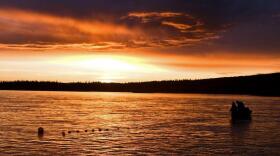In weekly meetings of the longstanding Kuskokwim River Salmon Management Working Group, state and federal fisheries managers, tribal representatives, and a wide range of voices come together to paint a picture combining biological data and first-hand accounts from people who live on the Kuskokwim.
Amid crashing salmon runs, the group is a sounding board for the challenges being seen along the river. One hot topic right now is that it’s not just salmon runs that are getting smaller, but some of the chinook salmon that do return are becoming smaller as well.
During the July 5 meeting of the working group, Bethel Elder Robert Hoffman said that he was frustrated about the type of fishing gear being permitted.
“Yes, we have met our fish goals: reds, chums, and jack salmon,” Hoffman said. “But we have not reached our king salmon, what we used to call king salmon a long time ago, due to the fact that we only use 6-inch.”
Hoffman was referring to the maximum mesh size of the gillnets that federally qualified subsistence users are allowed to use during the limited number of openings on the Kuskokwim River. The nets are far less likely to catch large egg-bearing female chinook salmon on the final leg of their journey up the river, but they are great for catching smaller kings.
“We're trying to put as many of those big fish through the fishery and harvest more of the abundant, smaller, predominantly male fish,” Nick Smith, an area management biologist with the Alaska Department of Fish and Game, said.
Smith said that there have been fewer chinook salmon returning to the river, and that the runs are changing.
“The males are getting younger, the age they come back, and then so are the females,” Smith said. “So what traditionally was a six-year-old female making up a lot of the run is now five-year-old females.”
According to Smith, half of the chinook salmon that returned to the Kuskokwim River in 2022 were even younger, age four. Males that are age four or younger are known in Alaska as jacks.
While the juvenile chinook that leave Alaska’s rivers are known for spending years at sea packing on the pounds, a sizable percentage return far earlier. The jacks are sexually mature, but small. Smith said that the typical jack spends one to three years at sea. Among the many jacks swimming up the Kuskokwim River, there are even a tiny percentage of what are known as "jills": small female chinook that also return home early.
“Yep. I've seen jill kings before,” Smith said.
Upon reaching the spawning grounds, the jills have a good chance of finding a willing male partner. The jacks, on the other hand, are either chased away by larger males, or they must wait for the opportunity to get a piece of the fertilization action in what is known as “sneak mating.”
So, why are chinook salmon getting smaller overall?
“The sky's the limit right now on hypotheses for what is causing that. You’ve got climate change, you've got other competing hypotheses with stuff going on in the ocean. There's a term called late-stage mortality,” Smith said. “So are these fish dying from predators, from lack of nutrients to get old, or that they're returning because they get sexually mature faster? So there's not a silver bullet yet on what is causing this, but it's not a phenomenon that's just local to the Kuskokwim.”
Some point to factory trawler bycatch in the Bering Sea as a prime suspect. But a 2018 study published in the journal "Fish and Fisheries" suggested that a burgeoning population of northern resident killer whales may be targeting the larger fish in greater numbers.
Whatever the case, smaller chinook salmon and net restrictions aimed at selecting for these small fish mean that jacks, and the occasional jill, will likely remain a familiar sight on the Kuskokwim River.





